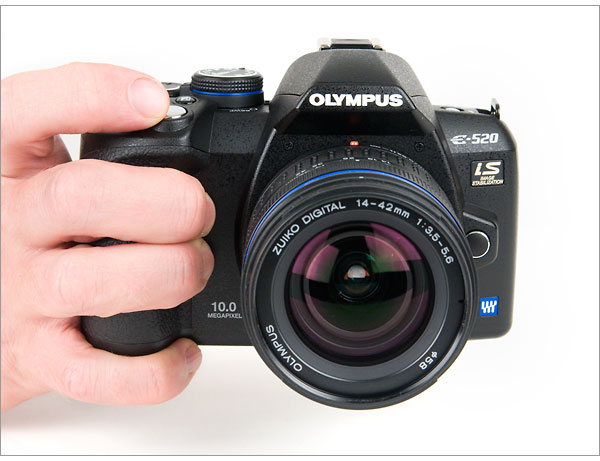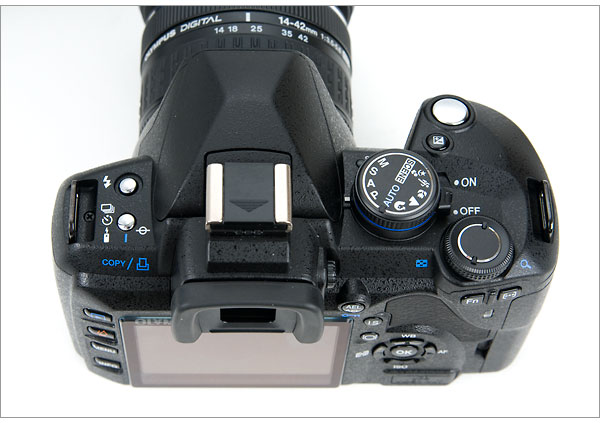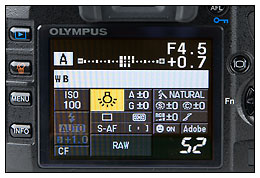Features
The Olympus E-520 might look small and insubstantial compared to some other DSLRs. But don’t let the size fool you. Olympus has packed a lot of features into the E-520 and it’s definitely more than the sum of its apparent parts.

One thing that sets the Olympus digital SLRs apart from Nikon and Canon (Pentax and Sony have similar built-in image stabilization systems) is the built-in, sensor-level image stabilization. No matter what lens you use, the image-stabilized sensor will compensate for camera shake. The E-520 has the same two axis image stabilization of previous models and a new IS mode for vertical panning.
The E-520 offers a full range of exposure modes, from full manual to full auto, with Program, priority modes, and scene modes to cover most any situation. The sensitivity range is ISO 100 to 1600 and there are five metering modes including spot, Hi Spot Metering (HI) and Shadow Spot Metering (SH). The Hi Spot and Shadow Spot modes compensate for bright or dark subjects so the photographer doesn’t have to. White balance options include auto, four presets, three programmable custom settings, and selectable color temperature. The camera also includes Olympus Shadow Adjust Technology. The Shadow Adjust feature lightens shadows to increase the dynamic range of contrasty photos (see below). It is applied automatically in scene modes, with Face Detection, and when Live View is being used. It can’t be used on RAW images, although RAW files can be converted to JPEG in the camera and then Shadow Adjust can be applied.

Olympus Shadow Adjust samples: Left image is not adjusted and the right photo has had Shadow Adjust applied. Click to see larger versions.
Auto focus can be set for single shot, continuous, manual, or S-AF+MF and C-AF+MF. The last two use auto focus but allow the photographer to manually override. There is no manual focus switch and unless you’re using one of the Olympus SWD lenses, the focus ring doesn’t even engage unless a manual focus mode is selected. That’s something I don’t recall seeing on any but Olympus DSLRs. The three auto focus points can be individually selected or you can let the camera choose the one it thinks is best. Face detection, a standard digital camera feature now, is also included.
Olympus was the first company to introduce Live View and an anti-dust system and the E-520 has both. The 2.7-inch 230k HyperCrystal II LCD can be used in Live View mode and auto focus – though slow – is possible. The E-520 has a built-in pop-up flash like other cameras in its class as well as wireless flash capability with either the Olympus FL-50R or FL-36R flashes. This camera offers a truly surprising level of customization, including the ability to change the direction of the focus ring or exposure dial. It can take some time and effort to discover all the possibilities. But if there’s something you don’t like, there’s a good chance it can be customized somewhere in the camera’s menu system.
![]()

All Olympus E-520 Camera Menus >>
Design
The main design element of the Olympus E-520 is its small size. It’s not as small as the Olympus E-420, currently the world’s smallest digital SLR. But within the overall DSLR size spectrum it’s very compact. The E-520′s Four Thirds sensor is smaller than the APS-C sensors in comparable DSLRs and makes it possible for Olympus to keep E-System camera bodies and lenses very compact. The E-520 body is actually about the same size as the Nikon F60 and Canon XS, but the smaller Four Thirds sensor and 2x digital crop factor makes smaller lenses possible and makes the overall package lighter and smaller than what you’d carry with a Nikon or Canon kit.

Like other entry-level DSLRs, the Olympus E-520 has a single dial exposure control system. There’s a thumb-accessed dial at the top right of the camera that changes exposure. You can toggle between aperture and shutter with a button just behind the shutter release button. For first-time DSLR owners, the single dial exposure control will be no problem. But for photographers used to having separate dials for shutter speed and aperture, it can take some getting used to. It can be even more difficult if this is a second body and your main camera has two dials. However, it does help keep the camera small and you can get used to it. I’ve learned to switch between the E-520 and two-dial cameras without much trouble.
 The camera’s controls are comfortable and intuitive. The various buttons and dials on the top and rear of the camera are labeled well and function easily. I really appreciate the ease of the LCD “Super Control Panel.” (See right) Just press the OK button and then use the arrow pad to quickly change settings like ISO, white balance, focus mode, metering mode, flash, and even color and image quality settings.
The camera’s controls are comfortable and intuitive. The various buttons and dials on the top and rear of the camera are labeled well and function easily. I really appreciate the ease of the LCD “Super Control Panel.” (See right) Just press the OK button and then use the arrow pad to quickly change settings like ISO, white balance, focus mode, metering mode, flash, and even color and image quality settings.
The E-520 is more menu-driven than other digital SLRs. That’s actually standard with Olympus digital SLRs. There are dedicated controls for the most used settings, like auto focus, white balance, ISO, image stabilization, and metering mode. But the camera also has layers and layers of menu controls and settings. There are pros and cons to the deep menu. On the one hand, the E-520 and other Olympus digital SLRs offer a level of customization I don’t believe is available from any other camera maker. They go as far as allowing the user to choose which direction the manual focus ring turns. However, it can take some effort to discover some important options and the menus can be confusing. For example, until I started writing this review, I thought the E-520 had no depth-of-field preview. Turns out the Fn button can be programmed for depth-of-field preview. So don’t ignore the customizable Fn button. The default Fn setting toggles face detection on and off, but it can also be programmed to control auto focus functions, custom white balance, and depth-of-field preview, and can even completely turned off.
next page – Olympus E-520 Camera Experience >>


I posted a link for this review along with a request for feedback on the Flickr Olympus E-System Community group page. I got a little more than I bargained for – possibly because this wasn’t a 100% glowing review. Some people seemed to miss the fact that I really like the E-520 and encourage people to consider it seriously. But within the grumbling about details, I was offered some very good criticism, as well as some error corrections. I believe I’ve fixed all of my mistakes (thanks, Velocity of Sound). And I’ve tried to address the criticism within the review without completely rewriting it. Specifically, I’ve rewritten the Conclusion and added a note about how I shoot to the end of the Image Quality section. But like I said, I don’t want to completely rwrite the review. The intention was to clarify some things, not defend every detail. I do want the review to be as useful and accurate as possible, though. And to that effect I appreciate the feedback.
If anyone wants more details about the criticism, you can check out the discussion about the review on the Flickr Olympus E-System Community forum. I have nothing to hide
Flickr Olympus E-520 Review Discussion
And if you want to discuss the review with the PhotographyREVIEW.com community, here is a link to our home thread:
PhotographyREVIEW.com Olympus E-520 Review Discussion
If you actually own the E-520 and want to share your opinion and experience, commenting here is great. But we really need your reviews on the Olympus E-520 user review page. That way you can leave a rating and add to the overall body of knowledge about the camera. Here’s a link to that review page:
Olympus E-520 User Reviews
Thanks everyone – especially the Flickr Olympus E-System Community folks – for your feedback. I hope it helps make this review, and future reviews more useful and easier to read.
This is a fair review. I bought the E520 and two kit lenses after researching all aspects. I was not starry-eyed about it. The camera has been a delight to use and is very well thought-out. Most of the features are ones you actually want. The Zuiko kit lenses are excellent and the kit is unbeatable value. Size and weight are good.
You have to learn to coax the best out of this camera, including in lower light / lower contrast situations. But it can be done. The in-body image stabilisation is excellent and there is faster glass available to offset the stop or two you lose on ISO compared with Canon or Nikon rivals. Image quality in normal range is excellent, and the colour rendition (of both lenses and sensor/processing engine) is superior.
Since buying the kit I looked at the Nikon 300, 700, & D90 but after four months of using the E520 every day I decided to stick with, and invest in, the E-system. I’ve acquired three more Zuiko lenses and they are….quite fantastic!
Very nice review John. I don’t own the 520 but have owned the 510 and currently the E3. I must say the 520 will be a good addition to the Olympus line up. I look forward to your reviews on the E-30 and also the G1. I got my eyes on the G1.